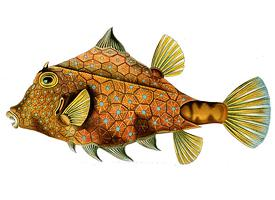
Greutăți și măsuri
| Lungime | 30 cm |
|---|
Descrierea animalului
The Camel Cowfish, scientifically known as Tetrosomus gibbosus, is a fascinating marine creature that captivates the attention of many due to its unique appearance and intriguing behavior. This species belongs to the family Ostraciidae, which comprises boxfishes, cowfishes, and trunkfishes. The Camel Cowfish is particularly notable for its distinctive shape and the peculiar way it moves through the water, making it a subject of interest among divers and marine enthusiasts.One of the most striking features of the Camel Cowfish is its body shape. Unlike many other fish species that have streamlined bodies to cut through the water efficiently, the Camel Cowfish has a boxy, almost angular body. Its body is encased in a hard, bony carapace, which serves as a protective armor against predators. The carapace is characterized by its humpbacked appearance, which is where the common name "Camel Cowfish" derives from. This unique body structure makes the Camel Cowfish a slow swimmer, relying more on maneuverability than speed to navigate through its environment.
The coloration of the Camel Cowfish is another fascinating aspect. It typically displays a mix of yellow and olive hues, adorned with intricate patterns and spots that provide camouflage among the coral reefs and seagrass beds it calls home. These colors can vary depending on the fish's diet, age, and the specific waters it inhabits.
Camel Cowfish are found in the Indo-Pacific region, ranging from the eastern coast of Africa, across the Indian Ocean, to the western Pacific Ocean. They prefer shallow, warm waters and are commonly seen around reefs and lagoons, where they feed on a variety of small invertebrates, algae, and plankton. Their diet contributes not only to their coloration but also to their overall health and the development of their unique body shape.
Despite their slow swimming speed, Camel Cowfish have a remarkable defense mechanism. When threatened, they can release a toxic substance from their skin, which is harmful to potential predators. This toxin, known as ostracitoxin, can deter most predators, but it also poses a risk to the cowfish itself if released in a confined space, such as an aquarium.
The reproductive habits of the Camel Cowfish are not well-documented, but like many marine species, they are believed to release eggs and sperm into the water column, where fertilization occurs externally. The larvae are planktonic, drifting in the ocean currents until they develop into juveniles and settle on the reef.
In conclusion, the Camel Cowfish is a remarkable species that stands out not only for its unusual appearance but also for its unique adaptations to life in the marine environment. Its presence in the coral reefs and seagrass beds of the Indo-Pacific region adds to the biodiversity and beauty of these ecosystems, making the Camel Cowfish a cherished species among those who have the opportunity to observe it in its natural habitat.
Fotografii noi cu animale
Top 10 animale
- Dolphin gull (Leucophaeus scoresbii)
- Diana monkey (Cercopithecus diana)
- Moustached guenon (Cercopithecus cephus)
- Stone loach (Barbatula barbatula)
- Greek tortoise (Testudo graeca)
- Galápagos tortoise (Geochelone nigra complex)
- Japanese macaque (Macaca fuscata)
- Russian tortoise (Testudo horsfieldii)
- Common flying dragon (Draco volans)
- Galápagos penguin (Spheniscus mendiculus)